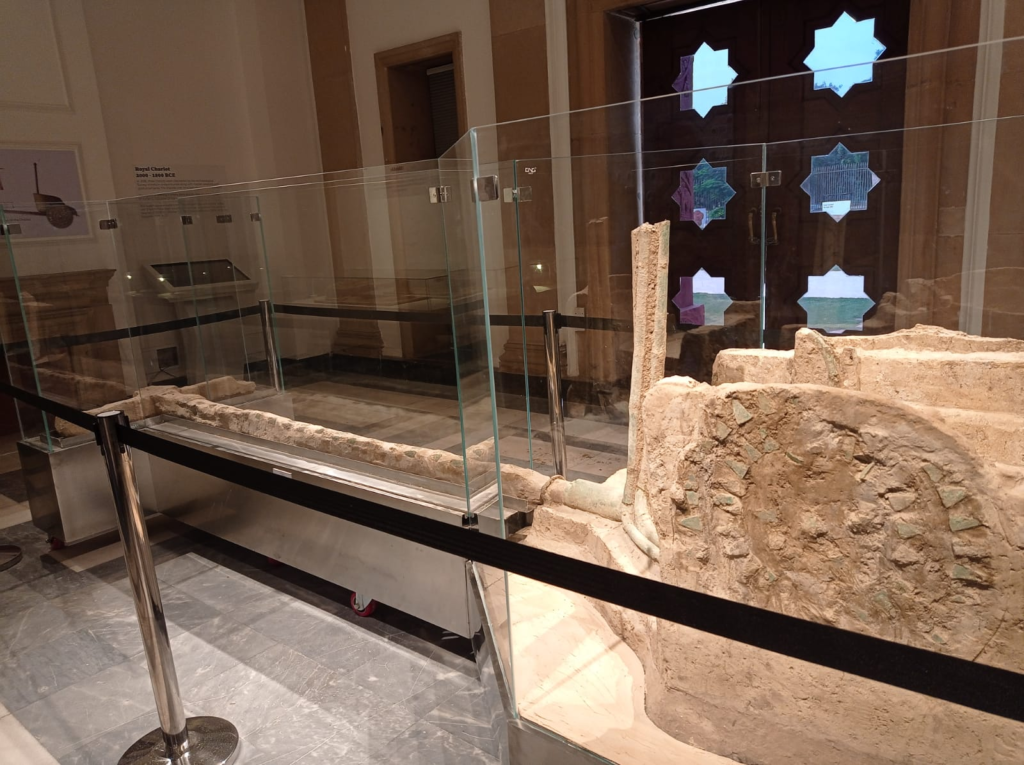Sindhu Saraswati Civilization denotes the pre-historical and historical settlements that began in north western and northern part of the Indian subcontinent around the mid-8th millenium BCE.
It includes, pre-Sindhu Valley Civilization cultures like the Hakra Ware culture, Sindhu Valley Culture and post Sindhu Valley cultures that prevailed after the Bronze Age Collapse.
Hakra Ware Culture – Bhirrana
Bhirrana in Haryana remains the oldest Sindhu Saraswati site with an established Hakra Ware culture. This culture is believed to have existed from the mid-8th millenial BCE to the mid-7th millenial BCE, making it one of the oldest dated civilizations (the oldest being Gobekli Tepe). It is widely accepted to be a materialistic culture.

Excavations at the Bhirrana site showed existence of dwelling pits, ceramics, mortar and pestle, semi-precious stones, chert blade, crucible, hopscotch made on a pottery and bone point, sling balls made of terracotta and sandstone.
Harappan Culture
The Harappan Culture found in multiple sites like Rakhigarhi, Dholavira, Harappa, Mohanjodaro, and many other sites were the part of a single culture spread from north in Afghanistan (Shortughai) to south in present day Gujarat (Somnath), from east in present day wester Uttar Pradesh (Alamgirpur) to west till far end of current Balochistan (Suktagen Dor).

Some unique facts about this culture was its consistency in measurement and unparalleled sanitation.
- Bricks were found of the same 1:2:4 ratio throughout its geographical spread.
- Almost all cities were divided into an upper city (for either elites or for “Shrenis“(merchant guilds) and a lower city (for residential purposes).
- The existence of a mature “materialistic culture” that paid a great attention to appearance, public meetings, jewelry, and terracotta figurines (probably used as toys or for decorative usage).
- All houses were arranged in grid pattern with each house having an attached toilet and these toilets drained their waste into a drainage system that collected city waste.
Sinauli Culture

Sinauli (Baghpat, Uttar Pradesh) proved something unique that showed the world that the world’s oldest chariot was found in India. Previously, it was thought that chariots were first invented in ancient Egypt or in the Central Asian steppes. The Sinauli chariot was found to be made around 2400 BCE, predating any chariot found till date.
What makes the “Sinauli Chariot” even more interesting that it had copper inlays in wheel spokes which confirms the existence of either a vast trade network or a very sophisticated copper working techniques.
There is an interesting video shot by Ranveer Allahabadia with former ASI chief Dr. K.K. Muhammad.
Another shocking discovery in Sinauli was the “royal burial” where the chariot was found. This burial clearly denotes the segregation of society possibly based on “Varna System”, much before the previously thought Vedic Age. This when connected with the rediscovery of the Saraswati River pushes back the date of Vedic Age to at least 3000 BCE.
We have classified the Sinauli Culture as different than the Harappan culture because of its relatively new discovery. In all likeliness, it might be an extension of the Harappan Culture, which is then a phase in continuity of the Sindhu Saraswati Civilization.




